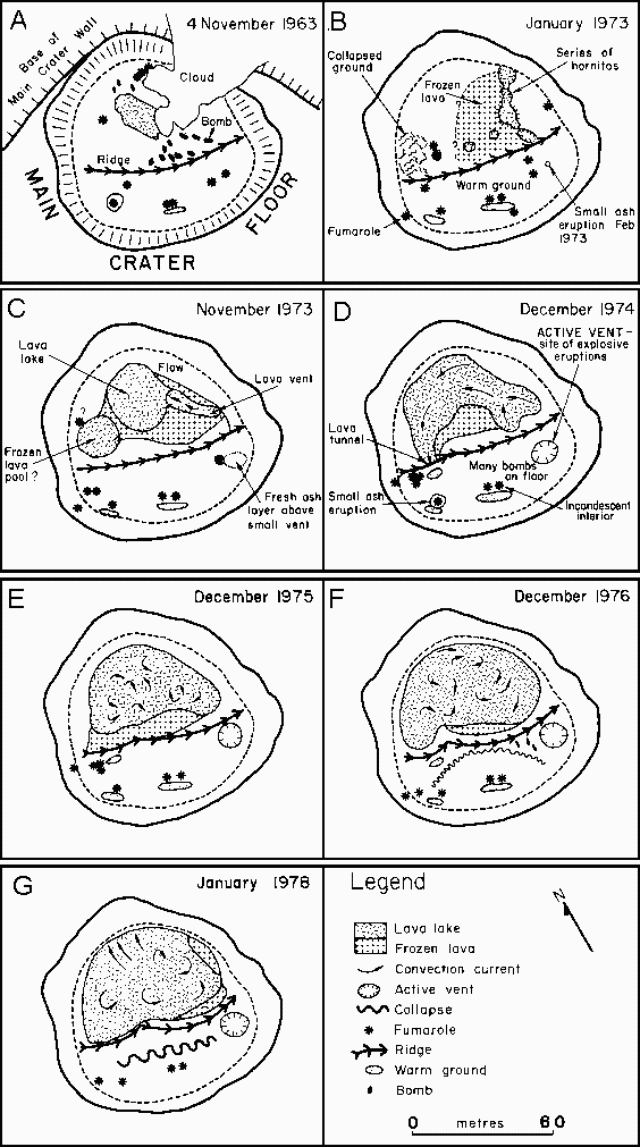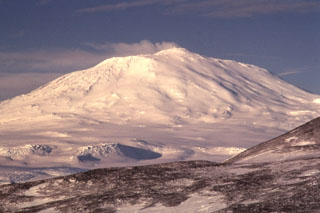Report on Erebus (Antarctica) — July 1978
Scientific Event Alert Network Bulletin, vol. 3, no. 7 (July 1978)
Managing Editor: David Squires.
Erebus (Antarctica) Strombolian activity increases and 15 years of lava lake history are summarized
Please cite this report as:
Global Volcanism Program, 1978. Report on Erebus (Antarctica) (Squires, D., ed.). Scientific Event Alert Network Bulletin, 3:7. Smithsonian Institution. https://doi.org/10.5479/si.GVP.SEAN197807-390020
Erebus
Antarctica
77.53°S, 167.17°E; summit elev. 3794 m
All times are local (unless otherwise noted)
The following is excerpted from Kyle and McIntosh (1978). "The most significant change in the activity during 1977-78 was an increase in explosive Strombolian eruptions. In the 1976-77 field season (22-31 December 1976) no explosive eruptions were heard, although in previous years they were frequent (Kyle and others, 1982). Compared to the 1972-75 period, eruptions during 1977-78 were more frequent and possibly larger in size. It is believed that most of the eruptions originated from the Active Vent. The number and size of the bombs were greater than observed in any previous season since observations began in 1971-72. Pelé's hair up to 100 mm in length was particularly common and was found lying on the snowy N flanks over 3 km from the crater.
"The persistent lava lake showed no apparent increase in size over that observed last year (figure 2). Subsidence along a large depression parallel to the ridge that divides the Inner Crater in half may be due to a slight lowering in the level of the magma column. On the E end of the lava lake, two raised benches of consolidated lava are also suggestive of a slight lowering in the lava lake.
 |
Figure 2. Summary of lava lake development, Mt. Erebus, November 1963-January 1978. From Kyle and McIntosh, 1978. |
"Activity within the lava lake consists of three main features: 1) lava upwelling in nearly circular areas; 2) small bubble-like degassing eruptions; and 3) downwelling of the consolidated crust along planar troughs or 'subduction zones.' While there was moderate and steady downwelling along the N wall, downwelling along central 'subduction' cracks was more rapid or at least more apparent. Migration of subduction zones themselves was the most easily observed surface movement. Upwelling was difficult to detect as it did not usually involve bubble formation; instead, a slight increase of incandescence and cracking of the lava crust was the main surface manifestation.
"Major element analyses of four bombs collected in 1977/78 are indistinguishable (within analytical error) from analyses of ejecta collected in previous years. The magma column is therefore not undergoing rapid changes due to crystal fractionation or influxes of new magma. Apparently the lava lake is the surface expression of a stable convecting column of magma."
References. Kyle, P.R.,. and McIntosh, W., 1978, Obervations of volcanic activity at Mt. Erebus, 1978: Antarctic Journal of the United States, v. 13, no. 4, p. 32-34.
Kyle, P.R., Dibble, R.R., Giggenbach, W., and Keys, J., 1982, Volcanic activity associated with the anorthoclase phonolite lava lake, Mount Erebus, Antarctica, in Craddock, C. (ed.), Antarctic Geoscience: Univ. of Wisconsin Press, Madison, p. 735-745.
Geological Summary. Mount Erebus, the world's southernmost historically active volcano, overlooks the McMurdo research station on Ross Island. It is the largest of three major volcanoes forming the crudely triangular Ross Island. The summit of the dominantly phonolitic volcano has been modified by one or two generations of caldera formation. A summit plateau at about 3,200 m elevation marks the rim of the youngest caldera, which formed during the late-Pleistocene and within which the modern cone was constructed. An elliptical 500 x 600 m wide, 110-m-deep crater truncates the summit and contains an active lava lake within a 250-m-wide, 100-m-deep inner crater; other lava lakes are sometimes present. The glacier-covered volcano was erupting when first sighted by Captain James Ross in 1841. Continuous lava-lake activity with minor explosions, punctuated by occasional larger Strombolian explosions that eject bombs onto the crater rim, has been documented since 1972, but has probably been occurring for much of the volcano's recent history.
Information Contacts: P. Kyle, Ohio State Univ.

